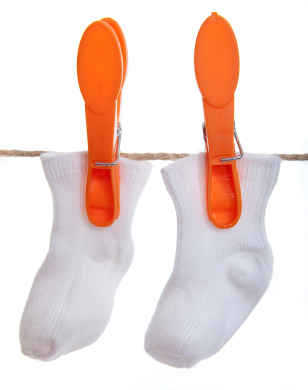
Unfortunately I am lazy and disorganised. One symptom of this is that I can never be bothered to fold up my socks in pairs when they come out of the wash. I just chuck them in the drawer. Another symptom is that I always wake up late for work and end up having to rush. Given that I only have white and black socks, how many socks do I have to grab out of my drawer at random to make sure the collection I've grabbed contains a matching pair?
This puzzle is part of the Hands-on risk and probability show, an interactive event culminating in Who Wants to be a Mathionaire? workshop sessions, which you can book to perform at your school. The puzzle appeared in the book How any socks make a pair? by Rob Eastaway.
For some challenging mathematical puzzles, see the NRICH puzzles from this month or last month.
ans
2+2
2+2??
3
first one is lets say black
second is (worst case scenario) white
third one will make a pair with either the first or second sock
3 is definitely right.
This is a simple application of the pigeonhole principle. If you have k pigeonholes and k+1 pigeons, then one pigeonhole will contain more than one pigeon.
third one will make a pair with either the first or second sock
yep
2
2
My sOlution
4
More colors
Likewise, an extension of the problem is 'how many socks do I have to pull out' if I have three colors? Four? n colors? When you see the solution for all of these, the answer, elegant (to me), is always 'colors + 1'. --That last one will always duplicate one of the previous colors for what is in this case defined as "pair". (Not that I would like to pull out six socks [for five colors] each morning, leaving the remains all over the sink, simply because I was too lazy to pair them in the first place.)
A then more challenging question is 'how many pulls' for two colors, to make THREE identical socks? Or three colors, three socks, etc.
General extension to the problem is c-color and n-group
The answer to above problem is c*(n-1)+1. Because the answer is strictly greater than c*(n-1) as the combination c11,c12,...,c1n;c21,c22,...,c2n;...;c(n-1)1,c(n-1)2,...,c(n-1)n (where cij is color j) is a possible outcome and contains no n-group of any color. Now, let us assume that we took out c*(n-1) socks and still there is no n-group than I claim that the outcome is a permutation of above mentioned outcome.
Proof of claim:
let ni, for i=1,2,3,...c be number of socks there are which have color j. And assume that there is no n-group.
Then:
for all i, ni<=n-1
summing up for all i:
sum(ni)<=c(n-1)
Now let us suppose that color I does not have n-1 number, then the sum(ni)
3
3
first lets say white
second black
third black or white either one it makes a pair
Silly me.
Haha. Even after reading the question several times, I spent ages trying to figure out how to guarantee the guy gets one of each colour, instead of just an individual pair. Anyway my answer for that (wrong) question was 1/2 all socks + 1. ^0^
Ho ho.
3 2 and a spare in cause you
3
2 and a spare in cause you get a black and a white so you then will either have a pair of white or a pair of black socks
3
3
if sock a is white,
and sock b is black,
then sock c can be either black or white and would make a pair
how many socks make a pair - solution
at first I was like 2 but then I thought this is supposed to be hard so then this puzzle got me thinking and I said it depends on the colour so for example you can have 1 black and 1 white you need another black or white sock to make a full pair so therefore the answer is ..... 3 ( in this case ) but logically you need 2 cause you only have 2 feet and to make a PAIR you need 2 like to apples make a pair 2 carrots make a pair etc. And that is my answer and I think most of you will agree !!!!
By ... Zainab !!!
3
If the first 2 socks don't match, then the third has to match with one of them as there are only 2 colours